Many nature lovers, professional flower growers and landscape designers consider gray spirea to be a universal crop, since it fits perfectly into any composition, goes well with other garden plants, has a long flowering period and has many other advantages.The article will discuss its varieties, features of planting and care, methods of propagation and replanting rules, as well as its application in garden design.
| Content:
|
|
Gray spirea is an unpretentious perennial shrub from the huge Rosaceae family, which is highly decorative and attractive. |
Description of spirea sulfur and brief agricultural technology
Gray spirea is a hybrid deciduous crop obtained in 1949 in Norway as a result of long-term breeding work. The basis of this species is St. John's wort spirea and whitish-gray spirea.
| Briefly about planting and caring for spirea sulfur |
|
Description and characteristics
The plant has numerous advantages and individual characteristics.
- It is characterized by rapid growth, growing up to fifty centimeters per year. Already three to four years after planting, the seedling takes the form of a bush and begins to bloom.
- High resistance to frost allows you to withstand temperatures up to thirty degrees minus without shelter.
- For about two months, starting in May, you can admire the magical flowering of spirea and enjoy the unique aroma of the inflorescences.
- The unpretentious culture calmly tolerates cold and heat, although sudden temperature changes are undesirable for it. For prevention, treatment with Epin, Zircon or other anti-stress and flowering-stimulating drugs is recommended.
- Strong immunity resists various diseases. Spiraea practically does not get sick.
- Loves loose soil, bright sunlight, moderate watering and timely fertilizing.
- The height of the bush and the diameter of the crown range from one to two meters, depending on the growing conditions. Root shoots are practically absent.
- The shrub consists of branched shoots with a tomentose-pubescent surface, pointed leaf plates with a dark upper side and a light lower side (ash-green hue), numerous corymbose inflorescences of a snow-white hue.
- It is a good honey plant.
- Used in making bouquets and various plant compositions.
Varieties of gray spirea
Grefsheim
|
Spiraea gray Grefsheim |
- The height of an adult shrub reaches two meters.
- Flowering begins in May and lasts an average of four weeks.
- White, pinkish and red flowers with a diameter of about one centimeter fill the surrounding area with a bright, rich aroma.
- The peculiarity of the foliage is gray-green shades in spring and summer, golden yellow in autumn.
- Even in the cold season, the plant remains highly decorative.
- The variety attracts a large number of insects and is a honey plant.
- Prefers moist and light soils with sufficient nutrients, sunny areas or light shade.
- It is resistant to drought, tolerates frosts well down to 25 - 27 degrees without shelter.
- Suitable for single and group plantings.
Graciosa
|
Spiraea gray Graciosa |
- The average height is from one and a half to two meters.
- Umbrella-shaped inflorescences of many small snow-white flowers with a diameter of five to eight millimeters have a pleasant aroma and are located on curved arched stems, reminiscent of the jets of a fountain or a waterfall.
- The period of abundant flowering lasts from May to June.
- It grows on almost any type of soil, but prefers fertile, drained and breathable soils.
- Resistant to prolonged absence of moisture.
- It tolerates pruning and shaping without stress.
- Overwinters without shelter at 26 - 28 degrees below zero.
- Used for decorating and landscaping various recreation areas, streets, and local areas. Tolerates urban conditions with high dust and gas pollution.
Planting spirea
Optimal timing for planting shrubs
Depending on the region, gray spirea can be planted in the fall at the end of September or in October, when the leaves begin to fall. Autumn planting is considered the most favorable. It is important that the seedlings have time to take root in a new place before the onset of cold weather. It will be much easier for stronger plants to survive the winter.Spring time is also used for planting young bushes. To do this, choose a cloudy day or late evening. You need to have time to carry out planting work before the buds begin to awaken.
Selecting a suitable site
If you choose a site according to all the rules, then the plants will not need replanting for many years and the annual growth will be ten to fifteen centimeters. The landing site requirements are:
- bright and uniform sunlight throughout the entire territory during the day;
- absence of sudden gusts of wind and drafts;
- absence of lowlands and swamps.
In semi-shaded areas, the growth of shrubs will slow down significantly and flowering will be less abundant. In the shade, gray spirea will lose its decorative effect and will develop and bloom poorly.
Preparing the soil and planting hole
Although gray spirea is an unpretentious plant, it is advisable to prepare high-quality soil for full growth.
- Peat and coarse river sand are added to heavy clay areas, and the bottom of the planting pit is covered with drainage material.
- Depleted and dried areas are fertilized with rotted humus, leaf soil, peat, wood ash and turf substrate.
|
Preparing a planting hole for planting a spirea seedling |
At the bottom of the planting pit with a clay base, it is necessary to lay a layer of broken brick or crushed stone in equal proportions with sand (expanded clay is possible) about fifteen to twenty centimeters thick. It is advisable to prepare the hole a few days before planting so that the soil on the walls dries out a little. For disinfection, it is treated with a manganese solution. The depth of the hole is about half a meter, the diameter depends on the size of the root part of the seedling and should exceed it by about a third.
Selection and preparation of seedlings
For planting, seedlings with closed and open roots are used. It is advisable to plant planting material with an open root system on the day of purchase. First, the roots of the plants are placed in a container with water for two to three hours, after which dry, rotten and damaged parts are pruned. Long roots and stems of seedlings are shortened three times.
Seedlings with a ball of earth can be kept for two to three days after purchase, but be sure to moisten the soil on the roots or in the pot with the plant.
Requirements for planting material upon purchase:
- there should be no damage, spots or signs of disease on the stems and exposed roots;
- the roots should be elastic, bend well and not be damaged by contact;
- the earthen lump should be in burlap or a plastic bag and be moderately moist;
- no parts of the root should peek out from the drainage holes of the container with the seedling;
- the buds on the seedlings must be healthy and not overdried;
- Plants with blossoming leaves should not be purchased.
|
It is advisable to purchase seedlings with a closed root system; they can be planted throughout the warm season |
Landing scheme and features
The planting pattern and spacing between crops depends on the purpose of the planting. In a group of plants, leave a distance of fifty centimeters to one meter, depending on the capabilities of the site. To create a hedge, the width between crops is from forty to fifty centimeters, between rows - from thirty to forty centimeters.
The soil removed from the planting hole is mixed with peat or sawdust, and a small amount of wood ash can be added.The finished mixture, about two to three centimeters thick, is poured onto the prepared drainage layer. Place the plant on top, straighten the roots, sprinkle with soil, compact it and water it abundantly. One seedling will require one and a half to two buckets of warm, settled water.
|
After planting the seedling, it is advisable to mulch the soil with peat, mown grass or old bark. |
Important! The root collar remains at soil level.
After about seven to ten days, when the soil settles, you can add a little more nutritious soil mixture.
Neighborhood with other cultures
Gray spirea perfectly coexists with different crops, but itself, growing strongly, obscures them and interferes with full growth and development. Perennial and annual flowers, conifers and other species and varieties of spirea can grow next to the lush bush.
Rules for caring for spirea
Proper watering and fertilizing, proper pruning and preparation for the winter period - this is all that a highly ornamental plant needs.
Irrigation regime
Gray spirea loves moist soil, so it needs to be watered regularly - about two or three times a month. During hot periods without precipitation, watering should be more frequent - up to twice a week. Fifteen liters of water are added to each bush. If the month turns out to be rainy, then additional moisture is not required; natural precipitation is sufficient.
When and what to feed
Deciduous shrubs require two mandatory feedings per season - after spring pruning and shortly before flowering.
The first is an infusion based on bird droppings, mullein with the addition of several granules of superphosphate.
The second - with ready-made fertilizer “Kemira - universal” (according to the instructions).
|
Gray spirea is very easy to care for |
Soil care
In the absence of a mulch layer, regular weeding and loosening of the soil to a shallow depth is recommended. Weeding - as necessary, loosening - after each watering and before applying fertilizers. Mulch will save the gardener from these procedures, feed the plant and maintain soil moisture for a longer period.
Don't forget to read:
Frost-resistant ornamental shrubs for planting in the countryside ⇒
Preparing for winter
High winter hardiness allows mature shrubs to remain without shelter even in the harshest winters. The exceptions are snowless periods and sudden temperature changes. Spiraea tolerates such vagaries of weather painfully; it is advisable to cover the root zones with fallen leaves and peat.
Young bushes are covered with a thick layer of dry grass, spruce branches, and straw. You can use burlap on top.
Trimming and shaping
Every year, in early spring (around the end of March - beginning of April) sanitary and formative pruning. Dried, damaged, diseased and weakened shoots are completely removed.
The first anti-aging haircut is recommended only seven years after planting. The bush is cut off completely, at the root, or ten to fifteen centimeters are left from the soil surface. After this procedure, young shoots actively grow in large numbers.
|
Scheme for pruning gray spirea |
Pruning after flowering is considered very important and, if done correctly, very effective. To increase the density and lushness of the bush, the shoots are slightly shortened. After a certain period of time, many new branches are formed and the decorative value of the crop increases significantly.For abundant flowering next season, it is necessary to remove the already faded old shoots to strong buds. It is advisable to cut off old branches aged seven years and older completely.
Reference! After flowering, adult gray spirea bushes are pruned by about a quarter, and young specimens are only shortened slightly. The first pruning is only two years after planting.
Methods for propagating spiraea sulfur
Gray spirea can be propagated in several ways - by cuttings, dividing the bush and layering. The seed method is ineffective and is practically not used.
Cuttings
Immediately after flowering is complete, old woody shoots are selected from the bushes, the top and part of the foliage are removed, and even cuttings ten to twelve centimeters long are cut. Each cutting should have five to six leaves. At night, the planting material is placed in a container with a biostimulator, and the next day it is planted in a sand-peat mixture at an angle of forty-five degrees. It is advisable to cover each stalk with jars or a plastic bottle.
Care consists of maintaining moderate humidity of the substrate and high humidity in the room. Rooted seedlings are transferred to open ground next year.
By layering
This method is very popular because of its ease and simplicity. In the spring, before foliage appears on the bushes, the lowest shoot is bent to the ground, pinned with wire, sprinkled with soil and watered. With regular watering, by the time autumn arrives, the cuttings will have formed their root system and will be ready to separate from the mother plant. You can leave the cuttings in the ground until spring. Then, before the arrival of cold weather, it is recommended to cover them with a thick layer of dry leaves or spruce branches.
Dividing the bush
The bush is divided during transplantation. In autumn, the plant is removed from the ground, the root part is cleared of soil and divided into three to four parts so that each remains with one healthy bud and two or three shoots. The incision sites must be treated with a disinfecting solution or sprinkled with ash. The divisions are planted immediately.
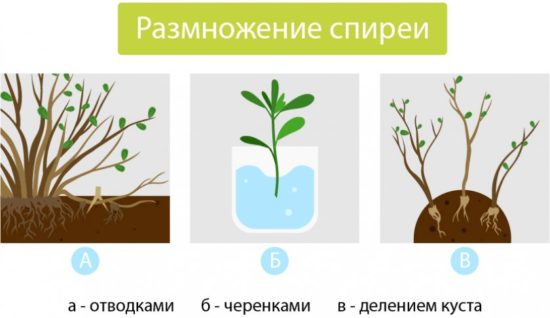 |
Transplanting a plant
In the spring before the buds open or in the fall after the leaves fall, there comes a favorable moment for transplanting an adult bush to a new place. In three to five days you need to dig and prepare a planting hole. Each one needs to be fertilized with potassium and phosphorus.
The spirea is carefully removed from the ground, the roots that are too long are trimmed, and then, together with a lump of earth, they are placed on a piece of polyethylene or burlap and dragged to a new area. This method helps keep the entire plant safe and sound.
The bush is placed in a hole, covered with nutritious soil and watered with Kornevin solution. The tree trunk circle must be covered with mulch made from peat, sawdust or humus. It is recommended to drive four to six stakes around the circumference and fasten a damp piece of natural fabric stretched over the crop to them. It should be in contact with the crown and replenish it with moisture in the first three to five days after transplantation. After adaptation to a new place, the fabric is removed and the stakes are removed.
Use in garden design
Gray spirea is indispensable in garden design. It is excellent in solo performance, in mixed and combined plantings. With its help, you can delimit the territory, divide it into zones, create a hedge, decorate the shore of an artificial reservoir or a place near a gazebo.
|
Grefsheim spirea hedge. |
Everywhere the bush will look appropriate and harmonious. Flower growers and gardeners can safely implement their projects and plans.
|
Juniper and lilac bushes, thuja and forsythia, ash and maple trees, fruit bushes and trees will become worthy and beautiful neighbors for gray spirea. |
Spiraea goes well with flowering plants - daffodils, tulips, crocuses, peonies, primroses and others. It will lift your spirits in the vicinity of other species and varieties of spirea - Vangutta, Japanese, oak-leaved, willow-leaved, Billard.
|
Spiraea gray in a mixborder |
Blooming spirea will become even more expressive and attractive together with various decorative elements, large stones, furniture, and steps.
Diseases and pests
Possible diseases of spirea sulfur are septoria, ascochyta, ramularia. You can notice the onset of the disease by the spots that appear on the surface of the leaves. For treating plants, the preparations “Fundazol” or “Bordeaux mixture” are recommended. It is necessary to treat bushes before or after flowering.
Possible pests include aphids, spider mites, garden snails and, rarely, roseate leaf rollers.
How to deal with aphids
As a preventive measure against aphids, it is recommended to treat the bushes before flowering with herbal or other infusions based on celandine and wormwood, onions and garlic, tobacco and hot pepper. These solutions are also effective at the first appearance of uninvited guests. If the number of insects is significant, then proven and effective drugs will come to the rescue.The bushes are sprayed with ready-made solutions or sprays: “Aktellik”, “Karbofos”, “Fozalon”, “Pirimor”, “Etafos”, “Akreks”, “Fosfamide”, “Keltan”.
spider mite
Signs of a spider mite are cobwebs and damaged leaves with characteristic white spots, which gradually turn yellow, then dry out and fall off. A favorable time for the pest is a prolonged drought. For prevention during dry and hot periods, it is recommended to spray the bushes with water daily. Regular sprinkling during such periods will prevent the proliferation of pests. To combat spider mites, the same drugs are used as against aphids.
Garden snails
Garden snails love moisture and often settle on spirea bushes. They feed on leaves, and therefore the presence of pests becomes noticeable through damaged leaf blades. Preventive treatment with Fitoverm is recommended in early spring and after flowering. To combat large numbers of snails, you can use numerous folk recipes, including special traps or special chemicals.
Gardeners - amateurs and professionals in landscaping consider gray spirea to be an ideal option in the garden and dacha. Its main qualities are its amazing beauty and ease of cultivation.
You might be interested in:
- Spiraea Wangutta: description of the bush and recommendations for planting and care ⇒
- Japanese spirea: description, photo, planting and care ⇒
- How to properly plant and care for thujas ⇒
- Hydrangea paniculata: photo, planting and care ⇒
- Ornamental trees and shrubs: photos, description, planting and care ⇒
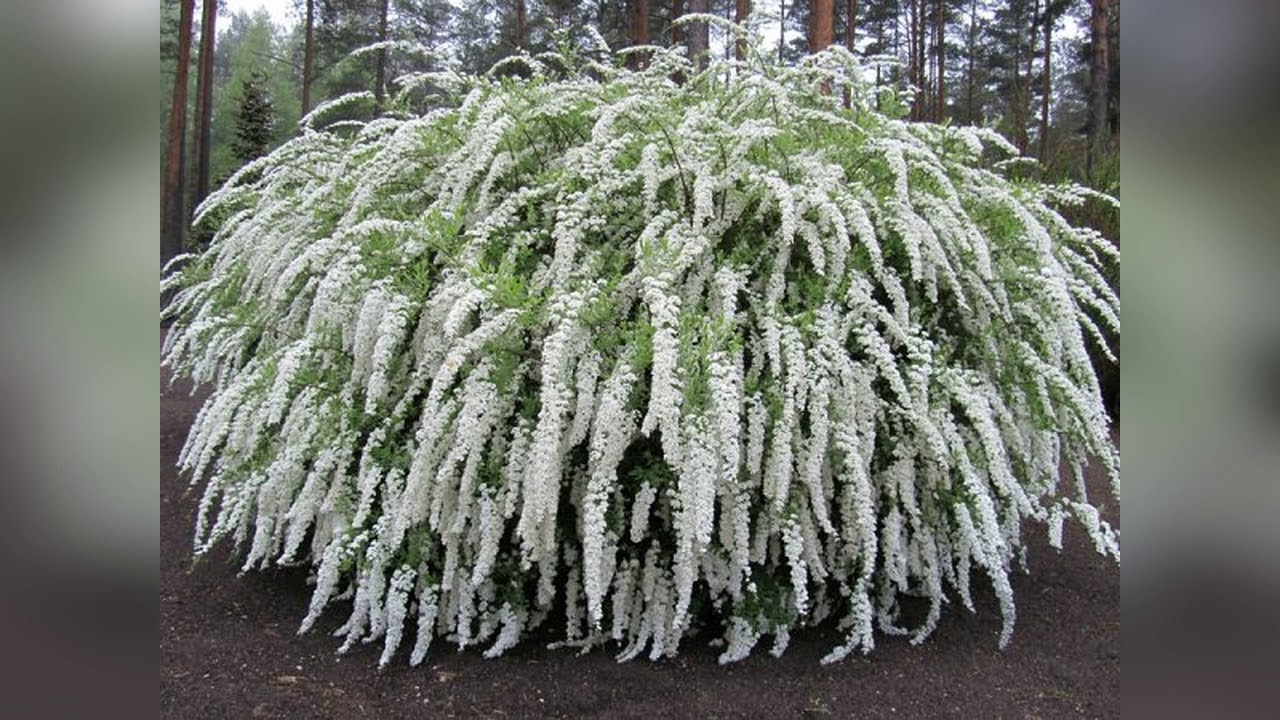

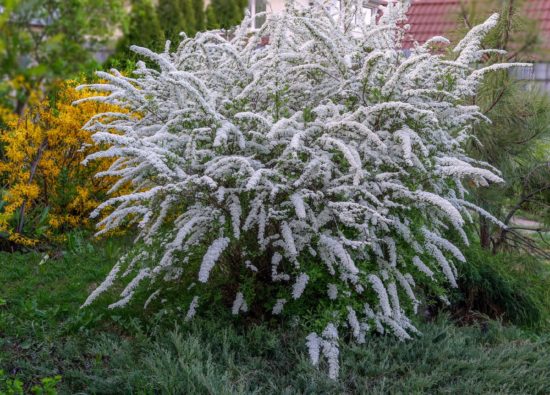
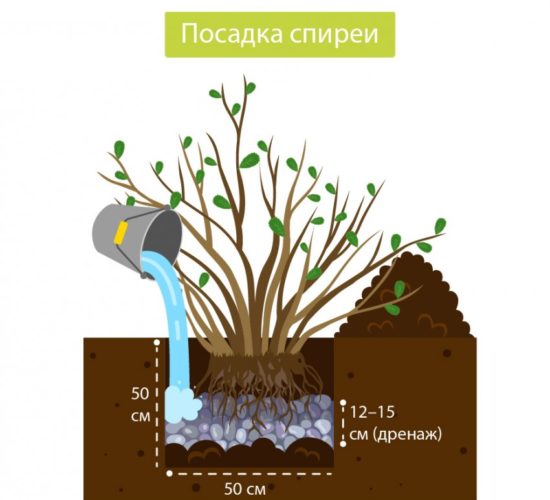
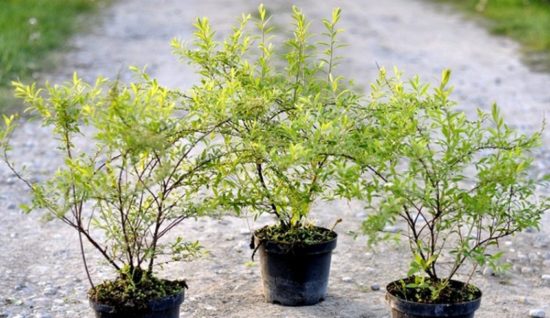
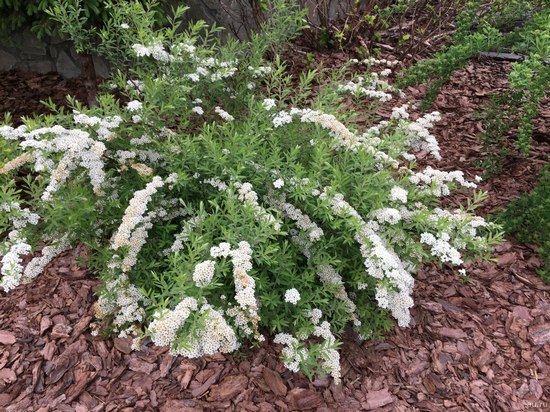
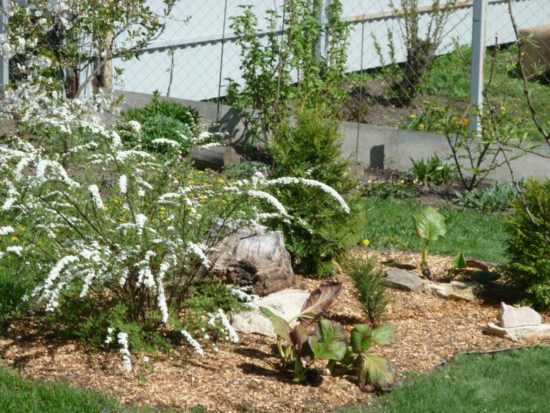
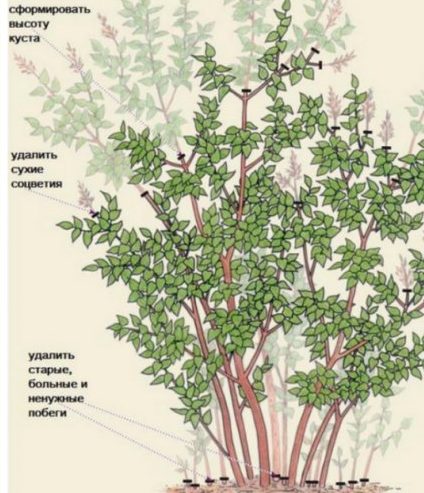
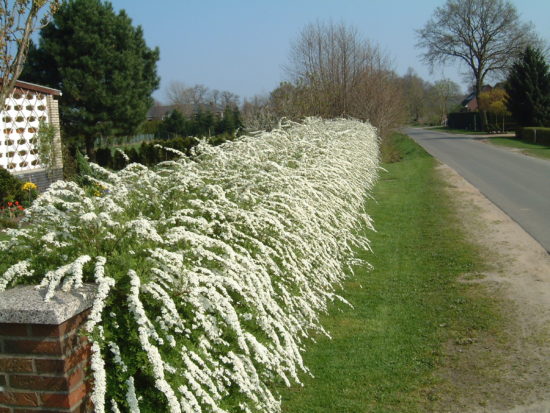
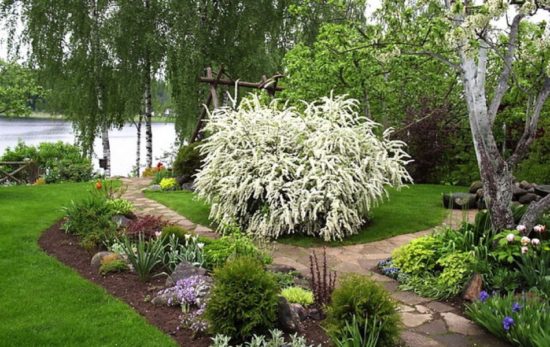


 CUCUMBERS NEVER GET SICK, I'VE BEEN USING ONLY THIS FOR 40 YEARS! I SHARE A SECRET WITH YOU, CUCUMBERS ARE LIKE THE PICTURE!
CUCUMBERS NEVER GET SICK, I'VE BEEN USING ONLY THIS FOR 40 YEARS! I SHARE A SECRET WITH YOU, CUCUMBERS ARE LIKE THE PICTURE! You can dig a bucket of potatoes from each bush. Do you think these are fairy tales? Watch the video
You can dig a bucket of potatoes from each bush. Do you think these are fairy tales? Watch the video
 How our fellow gardeners work in Korea. There is a lot to learn and just fun to watch.
How our fellow gardeners work in Korea. There is a lot to learn and just fun to watch. Eye trainer. The author claims that with daily viewing, vision is restored. They don't charge money for views.
Eye trainer. The author claims that with daily viewing, vision is restored. They don't charge money for views. A 3-ingredient cake recipe in 30 minutes is better than Napoleon. Simple and very tasty.
A 3-ingredient cake recipe in 30 minutes is better than Napoleon. Simple and very tasty. Therapeutic exercises for cervical osteochondrosis. A complete set of exercises.
Therapeutic exercises for cervical osteochondrosis. A complete set of exercises. Which indoor plants match your zodiac sign?
Which indoor plants match your zodiac sign? What about them? Excursion to German dachas.
What about them? Excursion to German dachas.